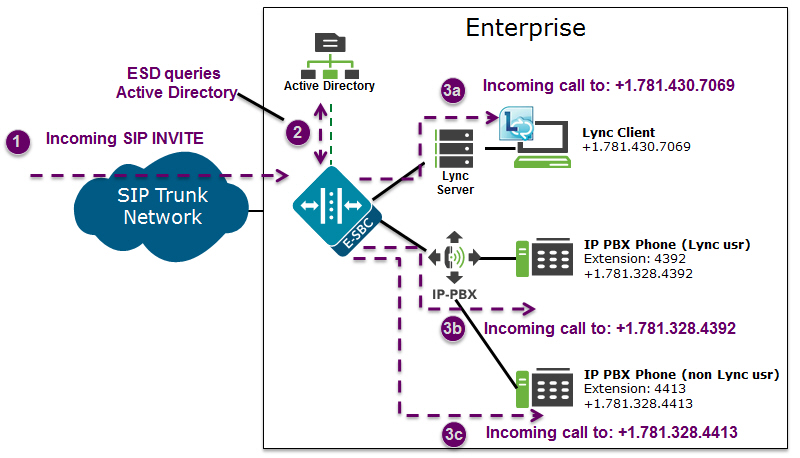Active Directory-based Call Routing
A large percentage of Enterprises currently use call servers with Active Directory (Domain Controller) such as Media Servers, Exchange Servers, Lync Servers, etc. For Enterprises that integrate these servers in parallel to their existing communications infrastructure, or transition from their legacy Private Branch Exchange (PBX) to these types of servers, Active Directory becomes a more efficient and cost-effective way of routing the incoming calls within the core Enterprise network.
Clients using Microsoft servers such as a Lync Server deploy their own URI. Therefore, a user in a network with both a desk phone and a Lync client have an IP PBX extension/URI for the desk phone, and a different URI for the Lync client. Currently, all PSTN traffic is sent by default, to a legacy PBX in the core network. If the PBX does not recognize the extension/URI, the PBX forwards it to the Lync client. Sending traffic to the PBX first and then to the Lync Server can be costly in terms of compute resources and/or licensing fees. Routing all incoming sessions from a SIP trunk to the Lync Server first and then to a PBX can be costly.
As a solution, the Oracle® Enterprise Session Border Controller initiates a query to the Active Directory to initially determine the type of incoming call. The Oracle® Enterprise Session Border Controller then stores data used to facilitate the routing decision of the call (performed by Lightweight Directory Access Protocol (LDAP)) and then routes the call the first time to the applicable destination (PBX or Lync Server).
In scenarios where a user has both a Lync phone and a legacy PBX phone, calls destined for the Lync phone number can be routed to the PBX phone number, or calls destined for the PBX phone number can be routed to the Lync phone number. The destination is dependant on the current Oracle® Enterprise Session Border Controller configuration. The Oracle® Enterprise Session Border Controller uses the information stored in the Enterprise’s Active Directory, compares it to the ESD configuration and then determines which phone number to utilize for the destined user.
Note:
The Active Directory-based call routing feature supports confidential and secure LDAP traffic support by using SSL/TLS (LDAPS).Active Directory-based call routing is a feature of the Oracle® Enterprise Session Border Controller that facilitates the routing of incoming calls to the appropriate destinations within the Enterprise core network. The Oracle® Enterprise Session Border Controller’s LDAP query to the Active Directory yields whether or not the phone number is associated with a call Server or the PBX.
When the
Oracle® Enterprise Session Border Controller receives an inbound SIP INVITE over a SIP Trunk (![]() ), it checks the current LDAP configuration in the
Oracle® Enterprise Session Border Controller. Depending on this configuration, the
Oracle® Enterprise Session Border Controller then accesses the Enterprise’s Active Directory to search for the applicable number being called via an LDAP query (
), it checks the current LDAP configuration in the
Oracle® Enterprise Session Border Controller. Depending on this configuration, the
Oracle® Enterprise Session Border Controller then accesses the Enterprise’s Active Directory to search for the applicable number being called via an LDAP query (![]() ). When the query has found the number to forward the call, the
Oracle® Enterprise Session Border Controller routes the call directly to the call server client (
). When the query has found the number to forward the call, the
Oracle® Enterprise Session Border Controller routes the call directly to the call server client (![]() ) or to the IP PBX phone (
) or to the IP PBX phone (![]() ) and
) and
![]() ) as shown in the illustration below.
) as shown in the illustration below.

The Enterprise is responsible for migrating phone numbers from the legacy PBX to the call server by making the necessary updates in their Active Directory in order for the Oracle® Enterprise Session Border Controller to route the call properly. In the illustration above, the IP PBX extension (4392) is the primary telephone number (+1.781.328.4392); a secondary transition number (+1.781.430.7069) is assigned to Lync.



